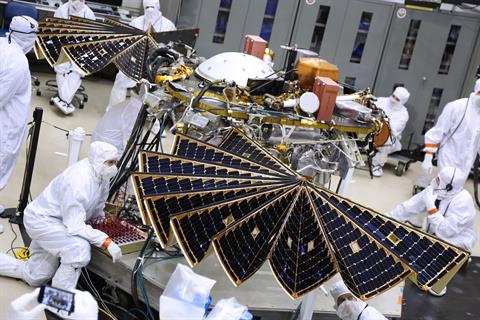Learn More: Planetary Protection Policies and Practices Course
Updated: This article was updated for timeliness.
NASA’s Planetary Protection program offers the course “Planetary Protection: Policies and Practices” one to two times a year. This course, which has been active for more than 15 years, covers what the requirements are for Planetary Protection for robotic missions, how to meet those requirements and lessons learned from past missions.
“[The course covers] how we do things for real, not just the requirements,” explained Amy Baker, one of the courses instructors with SETI/Technical Administrative Services. “We have documents telling us what to do but we [also] have a long precedence of how we do it.”

The final deployment of the solar panels is captured in this photo taken in January of 2018. The photo depicts appropriate Planetary Protection gowning, taping and hardware handling during the final testing of the InSight solar panels. Final deployment and stow triggered the Office of Planetary Protection to conduct a final verification assay prior to “loosing access” to the panels preflight. Assays and independent verification requirements and strategies are part of the curriculum in the Planetary Protection course.
Specifically, the course typically covers
- What Planetary Protection is
- Treaties, regulations and government policies
- Biology of microbes
- Extremophiles
- Laboratory techniques and practices
- How to plan for compliance
- Guidelines for hardware design
- Probability of impact/break-up and burn-up
- Compliance, statistics, data analysis and reporting
- Real-time implementation lessons learned (the engineer’s perspective)
- Upcoming missions
- Laboratory results
The combination of lecture and lab work provides background and hands-on demonstrations for participants.
While the basic outline of the course and the topics remain mostly consistent, Baker and her colleague Michele Bahr adjust each offering based on feedback from previous participants as well as the existing knowledge base of those scheduled for the next offering.
“When we first started this course, nobody even knew what Planetary Protection [PP] was,” said Baker. “Now, most folks are familiar with PP or have worked with Planetary Protection requirements [themselves], so they have a more significant knowledge base.”
The course is taught by a number of instructors, all experts in the field with experience across various missions and an in-depth knowledge and ability to answer questions in a general way that applies to everyone.
“The teacher ratio is very, very high,” said Baker.
The course, which has a limited enrollment of 16 participants per offering, caters to individuals on NASA projects with Planetary Protection mission requirements and is recommended for anyone who needs to have a detailed knowledge of these requirements and their implementation.
“Planetary Protection: Policies and Practices” often has a wait list, so anyone interested should contact Baker.